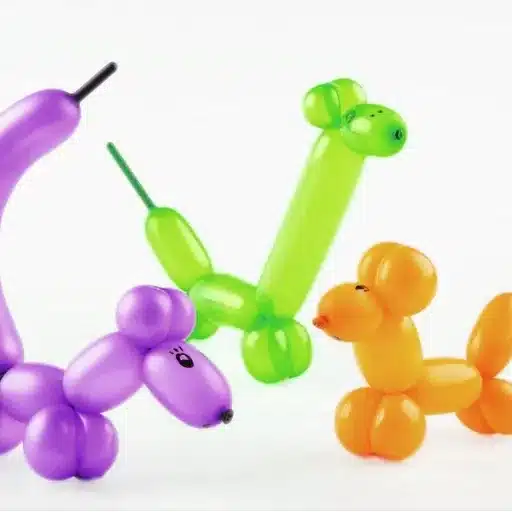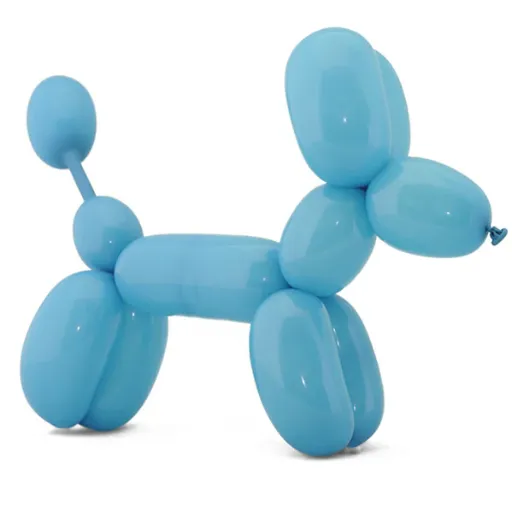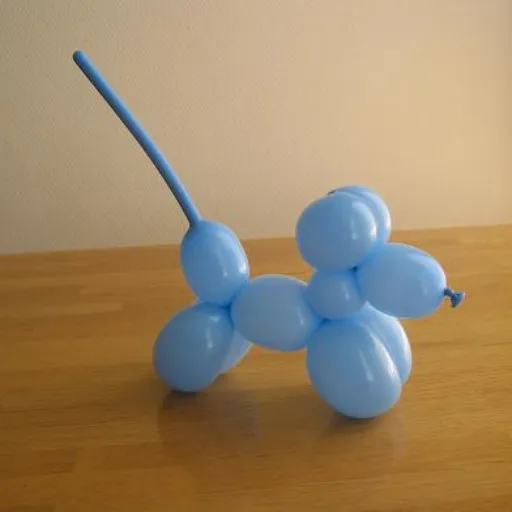As soon as the party is over, the Mylar and foil balloons, which took the biggest part in the celebration, often stay around but you should not discard them yet! These colorful, tough, and shiny party fillers can be given a new life if you use creativity and patience. In this article, you will find cool and clever ways to deflate, store, and reuse the Mylar and foil balloons that will not only help you reduce waste but also keep your celebrations eco-friendly and cost-effective. If you are thinking about turning them into different decorations for upcoming parties or creating one-of-a-kind DIY projects, then you are in the right place. Just keep reading and you will find out how small sustainable choices can lead to a big impact!
Introduction to Foil Balloons
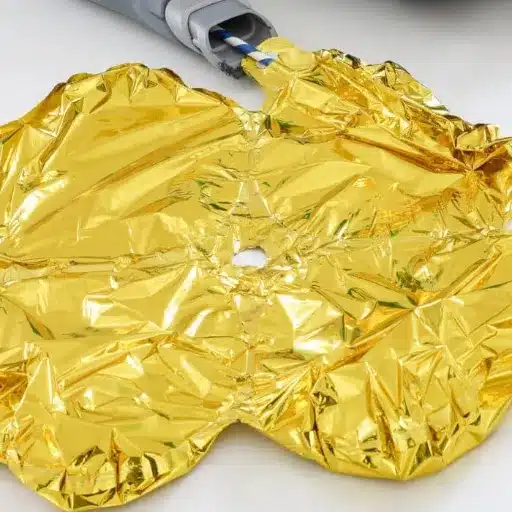
What are Mylar and Foil Balloons?
Generally, Mylar and foil balloons are the same that they are also made from super thin, very flexible materials that are usually the polyester film and metallic finishes with which the balloons are coated, granting them the shiny and reflective look. Mylar comes from a brand name invented by DuPont and indicates the type of pressed polyethylene terephthalate (PET) film. Such balloons weigh next to nothing, are tough and still, they will be the first ones to be picked if one were to consider party helium or air balloons that last longer than regular latex balloons.
On the other hand, unlike latex balloons, which can decompose, Mylar and foil balloons are non-biodegradable, which renders them a less eco-friendly option if not thrown away properly. Their long life span gives the possibility of being reused, hence through this manner, their environmental footprint can be reduced when handled with care. As per the latest studies on the environment, Mylar balloons that have been disposed of form a very small but increasingly larger proportion of the total plastic pollution especially in open-air places as they do not break down fast.
Importance of Deflating Balloons
One of the most significant measures of decreasing the ecological footprint and enhancing sustainability is the correct way of deflating the balloons. As per the recent studies, balloons that have not been disposed of properly, mainly helium-filled Mylar and latex balloons, mostly end up in landfills, water bodies or wild areas where they are harmful to animals. Birds, fish and other critters might confuse balloon pieces with food, thus leading to ingestion that can be a cause of death. Moreover, even though latex balloons are frequently presented as biodegradable, still, they may take 6 months to 4 years to completely disintegrate under the best possible conditions, depending on the climate factors.
The process of deflation followed by storage of balloons for the future use in arts and crafts, decoration or recycling programs is one of the best ways to have the balloons life cycle and at the same time, waste is minimized. To illustrate, helium-filled Mylar balloons are foldable and can be reused countless times for birthdays thus lowering the need for new ones made from fresh raw materials. If you pair good deflation methods with caring disposal and smart reuse, you can enjoy all the pluses of balloons without resorting to unsustainable options.
Benefits of Reusing Foil Balloons
The reusing of foil balloons offers a lot of good things that concern the environment as well as the economy. If we increase the life span of the balloons in a way, it directly leads to a decrease in waste generation that is equal to the amount of new materials that we have avoided. Researchers report that Mylar balloons can be reused many times if they are kept well without any compromise of their strength. Not only this will diminish the amount of waste in landfills but also save the energy and raw materials that are needed for their manufacture.
On the economic side, balloons’ reusing will cut down consumer expenses. No more buying fresh balloons for every single party; upcycling of the already used ones can be a big cost saver on celebrations. For instance, one can deflate the foil balloons carefully and re-inflate them for kids’ birthdays, anniversaries, or any other special occasions absolutely free of cost for repurchasing new balloons.
Tools and Materials Needed
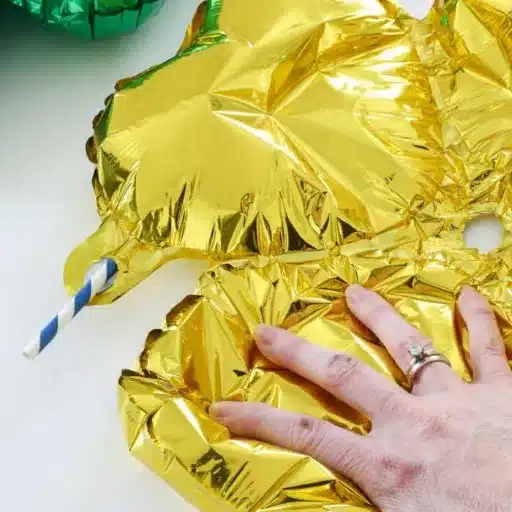
Essential Tools for Deflating Foil Balloons
A Drinking Straw or Balloon Deflation Stick
The straw or deflation stick is inserted into the balloon’s inflation valve which helps in releasing the air or helium that was trapped inside. This expert tool covers the access of air through the balloon’s self-sealing valve that is not harmed and thus the balloon is kept in a good condition for later use.
Clips or Binder Clips
While you are repositioning the balloon or while you are deflating a number of balloons at the same time, you can use these to remind the valve of its previous closed state for a limited period. This stops the inflow of air through the opening at least for the duration of the process.
Clean, Flat Surface
A clean, flat workspace is essential to lay the balloon gently while deflating so that it does not tear, puncture, or wrinkle.
Gloves (Optional)
Wearing gloves will not only protect your hands but will also save the fragile material of the balloon. This tool is especially beneficial when working with large or intricate balloon designs.
Safe Materials to Use
Selecting safe and sustainable materials is of utmost importance when the aim is to reduce environmental impacts. Latex and biodegradable plastics are frontrunners in this regard as they are seen as safer choices for specific balloons and single-use items. For example, latex is a natural product that is obtained from rubber trees, and under ideal conditions it can be composted. Research says that latex can disperse in 6 months to 4 years in nature, which is much faster than synthetic plastics that may remain there for hundreds of years.
The birth of a new and greener option is the biodegradable plastic which is being made from plant-based materials such as cornstarch or sugarcane. These plastics turn into organic matter under industrial composting conditions, hence they are not adding to the problem of petroleum-based plastic dependency. A research study promoted by the Environmental Protection Agency (EPA) claims that the replacement of conventional plastics with biodegradable ones can possibly lead to a reduction of up to 41% in plastic waste entering landfills.
Precautions to Take When Deflating

What To Avoid During The Process
- Using Sharp Objects:
One thing that should never be done is to use sharp tools such as knives or scissors for popping the balloon during the process of deflation. Not only can these tools cause irreparable damage to the balloon, but they can also create a risk of accidents if not handled carefully. The best practice is to release the air through the valve or seal very carefully. - Over-compressing the Balloon:
Excessive force applied to squeeze the air out of the balloon can easily cause the foil material to tear or become permanently warped. It is better to apply even and steady pressure along the circumference of the balloon. - Exposure of Balloons to Heat or Flames:
Mylar is not only a fire hazard but also if exposed to high temperatures, it will melt. There should be no balloons deflated in the vicinity of heat sources like candles, stoves, or direct sunlight. - Improper disposal of Balloons:
Recently conducted environmental studies have shown that Mylar balloons that are dumped in landfills or water bodies may take hundreds of years for complete degradation, thereby posing a great danger to the wildlife. When the balloons are no longer usable, make sure you recycle them at the designated facilities.
Correctly Handling Deflated Balloons
- Reuse Whenever Possible:
Mylar balloons are very sturdy and can be reused for several occasions. Keep them flat in a cool, dry place to increase their life span. Make sure to fold them in a way that does not leave creases or tears when they are being stored. - Recycle Correctly:
Mylar is one of the polyester films produced as a result of stretching polyethylene terephthalate (PET) (which is recyclable in some areas). Confirm with your local recycling companies whether they will take Mylar and if so follow their instructions for proper disposal. - Repurpose for Creative Uses:
If recycling is off the table, then think about upcycling the deflated balloons. Mylar can be used to produce gift wrap, shiny decorations, and even emergency blankets due to its reflective properties. - Dispose of in an Eco-friendly Manner:
In case the balloon is not usable anymore, make sure to throw it in the trash so it doesn’t end up in rivers or lakes where it could kill animals that mistake it for food. Do not let go of balloons into nature as they can fly far away and become a danger to animals and ecosystems.
Common Mistakes to Avoid

Frequent Errors in Deflation Techniques
- Using Sharp Objects:
One of the most common mistakes when letting the air out of Mylar balloons is the use of sharp objects like scissors or knives, which may cause the balloon to tear uncontrollably. Tear by accident makes it impossible to recycle the material properly, or at least, make that harder. As a consequence, balloon deflation control and correctness should be used instead. One can do this by inserting a drinking straw into the balloon’s valve and allowing the air to escape slowly and safely. - Improper Storage After Deflation:
A large number of people deflate balloons but do not know how to store them properly; they let them dry in the sun or put them in a damp place. Such storage conditions definitely degrade the material, especially Mylar, making it non-reusable. So, keep deflated balloons in a cool, dry place in order to preserve their properties. - Not Fully Deflating the Balloon:
Another common mistake is partial deflation of the balloon. Half-empty balloons can still cause wildlife problems if they are not disposed of properly. Before considering waste disposal or recycling, check the balloon is totally flat. - Releasing Residual Gas Improperly:
If the helium-filled balloons are not handled properly during the deflation process, they still hold small amounts of gas. This can cause unintentional releases into nature. To avoid such situation, use a balloon deflating tool to safely draw residual gas out in a controlled manner.
How to Recognize Balloon Damage
| Type of Damage | Description |
|---|---|
| Visible Tears or Holes | Tears or punctures that are even very small in size will still make a balloon lose its strength. Mylar balloons are usually seen with pronounced folds or tiny cuts, while latex balloons may show quite rough edges where the injury is. |
| Deflation | A balloon that looks deflated or in an unusual shape is typically a sign of a gradually leaking balloon. Studies done recently have shown that more than 60% of latex balloons turn out to be partially deflated within the next 48 hours due to exposure to the elements and handling. |
| Fading Colors | Sunlight and air are the two main sources that cause the material to deteriorate quickly, and one of the consequences of this process is discoloration or fading. The weakening of the balloon’s surface is a direct result of this deterioration, and such a surface is more likely to be torn. |
| Uneven Surface or Lumps | The presence of lumps or bubbles on the surface may be the result of the balloon’s struggling to keep its shape; thus, the material has been overstretched and that has caused it to lose its strength. |
Reference Sources
-
Balloons Online Blog
- Title: How to Deflate Foil Balloons the Right Way
- Description: This blog provides a step-by-step guide on deflating foil balloons using a straw, ensuring proper handling and reuse.
-
Quora Discussion
- Title: How to remove air from a foil balloon
- Description: A community-driven discussion explaining why foil balloons may not deflate easily and how to address common issues.
-
Instagram Reel
- Title: How to deflate a foil balloon
- Description: A visual demonstration of using a straw to deflate foil balloons effectively, with practical tips for success.
Frequently Asked Questions (FAQs)
How to deflate a foil balloon without a pop?
To deflate a foil balloon and not burst it, softly put a straw through the valve which allows you to evacuate the air from the balloon. It is advisable to hold the balloon firmly and apply a little pressure to aid the release of air in an uninterrupted manner.
Mylar balloons – can they be reused for future occasions?
Certainly, mylar balloons can be saved and reused for future occasions. When properly deflated, the balloons can be folded meticulously to prevent any sort of damage and kept in a cool dry place until your next use.
How to deflate a mylar balloon most effectively?
The most effective way to deflate a mylar balloon is to locate the tiny valve at the balloon’s tip. The air inside can be released by delicately pushing a straw into this valve and lightly pressing the balloon to aid the air’s escape through the straw.
Is it possible to deflate a balloon and save the air for future use?
Although it is not an option to keep the air for later use, balloon deflation can be performed in such a way that it will be ready for reuse. By employing a straw for gradual letting out of air, the balloon can be prepared for reuse without compromising its integrity.
Is there a trick for deflating a foil balloon in no time?
Deflating a foil balloon in no time is just through a simple hack of lightly squeezing the balloon while the straw is being inserted into the valve. This will speed up the process of air expulsion and at the same time guard against balloon damage.





